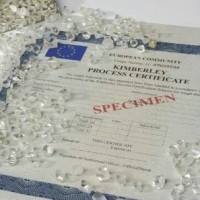In July 2000, the global diamond industry made clear to the international community its zero tolerance policy towards conflict diamonds. Dedicated to eradicating the trade in conflict diamonds, it worked closely with the United Nations, governments and non-governmental organizations (NGOs) such as Global Witness and Partnership Africa Canada to create the Kimberley Process Certification System. This system was formally adopted in 2003 and guards against conflict diamonds entering the legitimate diamond supply chain. The diamond industry also adopted a voluntary System of Warranties to assure consumers that their diamonds are from sources free of conflict.
Today 71 governments have enshrined into their national law the Kimberley Process Certification System, and now more than 99% of the world’s diamonds are from conflict free sources. However, even one conflict diamond is one too many. The diamond industry continues to work with governments, NGOs and the UN to strengthen the Kimberley Process and the System of Warranties.
While diamonds have been used to fund conflict, the problem is not the diamonds themselves but the rebels who exploit diamonds (along with other natural resources) to achieve their illicit goals. The vast majority of diamonds come from countries at peace. These countries have been able to invest the revenue from diamonds into the development of infrastructure, schools and hospitals for the good of the communities in which diamonds are found. These countries include Australia, Botswana, Canada, Namibia, Russia, South Africa and Tanzania.
Today, more than 99% of the world’s diamonds are now from conflict free sources and are officially traded under the UN mandated Kimberley Process.
Conflict diamonds came to the attention of the world media during the extremely brutal conflict in Sierra Leone in the 1990s. The UN, governments, the diamond industry and non-governmental organizations (such as Global Witness, Amnesty International and Partnership Africa Canada), recognized the need for a global system to prevent conflict diamonds from entering the legitimate diamond supply chain and thus helping to fund conflict.
They developed an agreement called the Kimberley Process, which requires participating governments to ensure that each shipment of rough diamonds be exported/imported in a secure container, accompanied by a uniquely numbered, government-validated certificate stating that the diamonds are from sources free of conflict.
Under the Kimberley Process, diamond shipments can only be exported and imported within co-participant countries in the Kimberley Process. No uncertified shipments of rough diamonds will be permitted to enter or leave a participant’s country. This ring-fences conflict diamonds and as such ensures they are unable to enter the legitimate diamond supply chain and thus, cannot be used for illegitimate purposes.
In November 2002, 52 governments ratified and adopted the Kimberley Process Certification System, which was fully implemented in August of 2003.
Today, 71 governments, in partnership with the diamond industry and NGOs, are committed and legally bound to the UN-mandated process. Kimberley Process participants currently account for well over 99% of the global production of rough diamonds dk-apotek.com/.
Kimberley Process participants undergo periodic reviews, along with peer monitoring to ensure compliance. Furthermore, all rough diamond sales are independently audited, and are also subject to separate governmental regulations. Any country that is found not to be in compliance can be sanctioned by the Kimberley Process.
All countries that are participants of the Kimberley Process are closely monitored. A recent Kimberley Process Review Mission to Brazil noted anomalies and weaknesses within the country’s procedures. The Brazilian Government took definitive action by suspending its official exports of rough diamonds and is in the process of working with the Kimberley Process to remedy the situation as soon as possible.
Kimberley Process Requirements
- Each shipment of rough diamonds crossing an international border must be:
- Transported in a tamper-resistant container
- Accompanied by a government-validated Kimberley Process Certificate
- Each certificate must be resistant to forgery, uniquely numbered and describe the shipment’s contents
- The shipment can only be exported to another Kimberley Process participant country
- It is illegal for uncertified shipments of rough diamonds to either be imported or exported by a Kimberley Process participant country
- Failure to comply with these procedures can lead to confiscation or rejection of parcels and/or criminal sanctions
- If any concerns arise regarding a country’s adherence to the Kimberley Process, they are investigated and dealt with at an intergovernmental level
Text taken from diamondfacts.org
